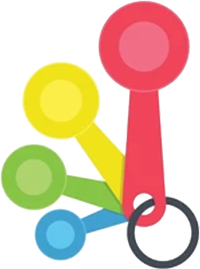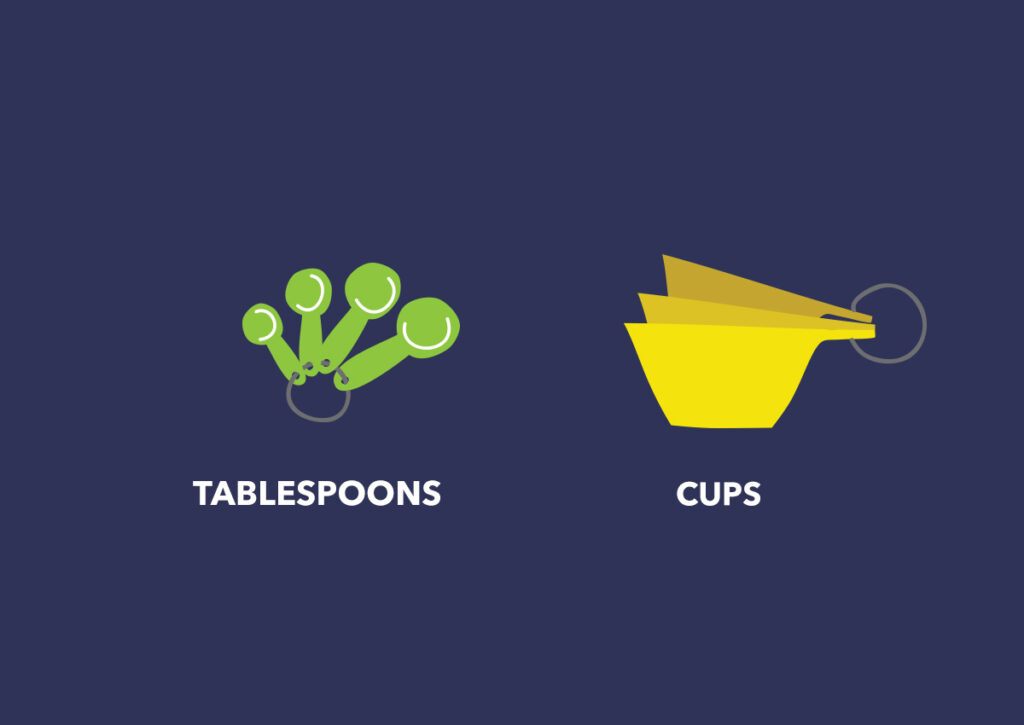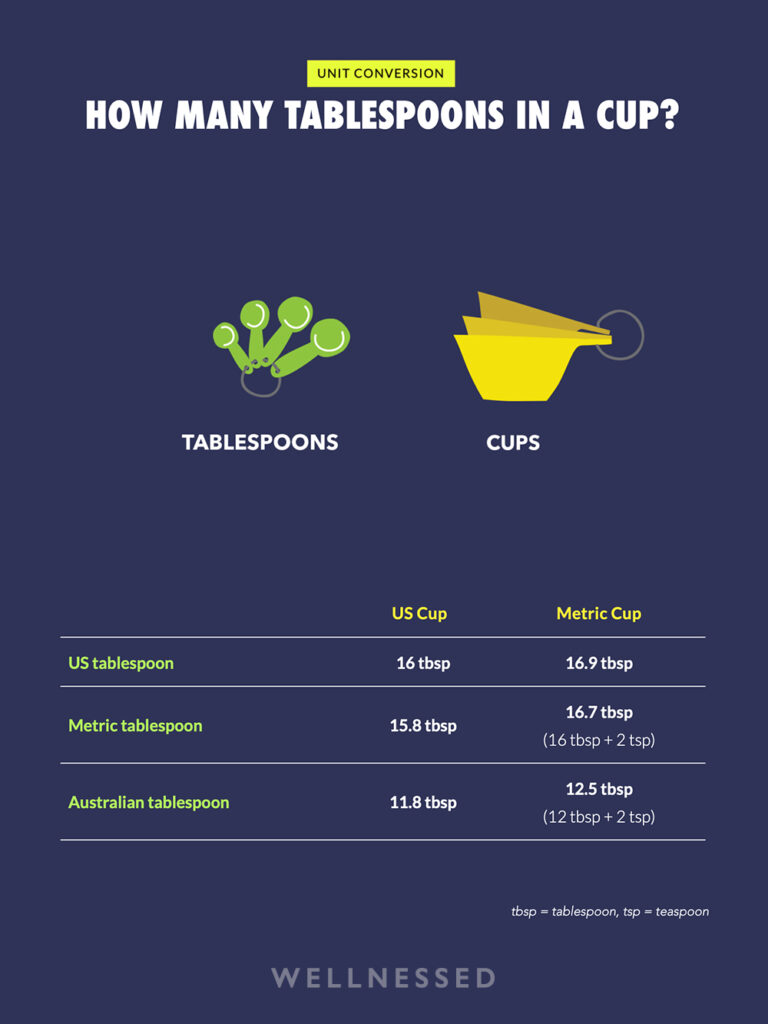There are 16 tablespoons in one cup in the United States. Cups and spoons are widely used for recipes in the US, which means it’s helpful to have a good understanding of how to switch between them.
Below is a tablespoon-cup conversion calculator to help you convert between cups and tablespoons. In this guide you’ll also find tablespoon-cup conversion charts, how to easily convert between cups and tablespoons yourself, and what you need to know about measuring cups and spoons.
Tablespoon-Cup Converter

Calculate how many tablespoons are in a US customary cup (or vice versa) with this conversion calculator. Enter the amount, select which conversion you want, and then click convert.
Cups and tablespoons are also used as a measure in other parts of the world. However, cup and tablespoon size are not the same as in the United States – important to know if you’re following an international recipe.
So yes, a tablespoon is a big spoon and a cup, is well, a cup. Both have been around for millennia. But there’s more to it when following a recipe. And the detail really does matter. So here’s your comprehensive, but totally simple guide to tablespoons and cups.
What is a Tablespoon?
In cooking, a tablespoon (sometimes referred to as tablespoonful) is a measure of volume, which is abbreviated tbsp, Tb, or T.
A tablespoon as a cooking measure is not the same size in every country. This is because the tablespoon is part of several different systems of measurement, each of which have a slightly different definition of tablespoon.
Types of Tablespoons
The three main types of tablespoons used across the world are:
- US tablespoon, is equal to exactly ½ fluid ounce, which is approximately 14.8 ml. There are 3 US teaspoons in a US tablespoon.1
- Metric tablespoon, is equal to exactly 15 ml. There are 3 metric teaspoons in a metric tablespoon. The metric tablespoon is used in Europe, Canada, and New Zealand.2
- Australian tablespoon, is equal to exactly 20 ml. There are 4 Australian teaspoons in one Australian tablespoon.3
American culinary expert Fannie Farmer introduced standardized measuring spoons and cups in the 1880’s and stipulated that measurements should be level, not heaped. Before Fannie Farmer created these uniform measures there was an array of cups and spoons in varying sizes, cookbooks were unclear, and it was difficult to successfully replicate a recipe.4
Her general reference cookbook The Boston Cooking School Cook Book popularized the use of measuring cups (volume measurement) across the United States, and cemented the move away from the scale as a cooking measure (weight measurement).5
What is a Cup?
The cup is a measure of volume. Though most popular in the US, measuring cups are used around the world. And just like measuring spoons, measuring cups are not the same size in every country. The size of the measuring cup depends on the system of measures being used.
Types of Cups
The two main types of measuring cups used across the world are:67
- US customary system. A US measuring cup is equal to 237 mL or 8 US fl oz. Used in the United States.
- Metric system. A metric cup is equal to 250 mL or 8.45 US fl oz. Used in countries that have adopted the metric system (including Australia, Canada, and New Zealand).
Other cups include:
- US legal measuring cup (240 mL), which is used on food labelling.
- British imperial measuring cup, which is equal to 284 mL. Mostly used in older British cookbooks.
- Canadian cup (227.3 ml), which has largely fallen out of use in favor of the metric cup.
- Japanese cup, which is 200 mL. And the gō (180 ml), which is the traditional Japanese cup still used for measuring rice and sake.
Here’s an easy chart showing how many tablespoons are in a cup for the most commonly used cups and tablespoons.
Conversion
How Many Tablespoons in a Cup?

| US Cup | Metric Cup | |
|---|---|---|
| US tablespoon | 16 tbsp | 16.9 tbsp |
| Metric tablespoon | 15.8 tbsp | 16.7 tbsp (16 tbsp + 2 tsp) |
| Australian tablespoon | 11.8 tbsp | 12.5 tbsp (12 tbsp + 2 tsp) |
tsp = teaspoon
Tablespoon and Cup Conversion Chart
Below is an equivalency chart of US cups, tablespoons, and fluid ounces.8US Cups US Tablespoons US Fluid Ounces 1/16 cup 1 tbsp ½ fl oz 1/8 cup 2 tbsp 1 fl oz 1/6 cup 2 tbsp + 2 tsp 1 ⅓ fl oz 1/4 cup 4 tbsp 2 fl oz 1/3 cup 5 tbsp + 1 tsp 2 ⅓ fl oz 1/2 cup 8 tbsp 4 fl oz 2/3 cup 10 tbsp + 2 tsp 4 ⅔ fl oz 3/4 cup 12 tbsp 6 fl oz 1 cup 16 tbsp 8 fl oz 2 cups 32 tbsp 16 fl oz
Cups & Tablespoon Conversion Formula
It’s very easy to convert between cups and tablespoons. If you don’t want to rely on a table, you can also use a conversion formula. The key number to remember to switch between cups and tablespoons is 16.
Tablespoons to Cups:
To convert US tablespoons to US cups, divide the number of tablespoons by 16.
Cups = tablespoons ÷ 16
Example
You want to convert 24 tablespoons to cups.
24 tablespoons ÷ 16 = 1.5 cups
In other words, divide 24 by 16, which equals 1.5 cups (which can also be written as 1 ½ cups).
Cups to Tablespoons:
To convert US cups to US tablespoons, multiply the number of tablespoons by 16.
Tablespoons = cups x 16
Example
You want to convert 2 cups to tablespoons.
2 cups x 16 = 32 tablespoons
In other words, multiply 2 by 16, which equals 32 tablespoons.
Measuring Wet & Dry Foods
There is often confusion surrounding wet and dry cups. But it doesn’t matter whether you’re using wet or dry ingredients, because wet and dry cups are the same. So whether you’re measuring milk, flour, butter, or herbs, one cup still equals 16 tablespoons (in the US).
How to Use Measuring Cups
There are different types of measuring cups for liquid and dry ingredients, which help increase accuracy when measuring. This particularly matters in baking, which is exacting. The two types of measuring cups are:
- Liquid measuring cups. These generally look like a transparent pitcher with a handle, spout, and measurement markings on the side. Used for liquids such as milk.
- Dry measuring cups. These cups hold the exact amount. They tend to be made of metal or plastic and come in a set of different sizes. Used for dry ingredients such as flour and sugar, and soft solids such as shortening.
Measuring liquids is rather straightforward, but measuring dry ingredients requires more consideration. Dry ingredients can be compressed, which changes how much will fit in the measuring cup. Therefore, be sure to fill the cup according to the method stipulated in the recipe instructions. For example, spooning the ingredient into the cup versus dipping the cup.
Also pay attention to whether the ingredient should be measured whole, chopped, sliced, or diced. Other instructions include heaping, rounded, firmly packed, and unpacked. Be particularly careful when measuring fine powders like flour, which are especially compressible.
Finally be aware of the (huge) difference between “1 cup chopped walnuts” versus “1 cup walnuts, chopped”. In the first example, the walnuts should be chopped before measuring, while in the second example the walnuts should be chopped after measuring. This makes a significant difference to the amount of ingredient you end up with.
- How to measure liquid. Place the liquid measuring cup on a level surface. Pour in liquid until the bottom of the meniscus (the bottom of the curved surface line formed by the liquid) is completely level with the desired mark. To confirm the correct measurement, bend down so that you’re at eye-level with the measurement line on the cup. Do not hold the cup up to your eyes.
- How to measure dry ingredients. Fill the dry measuring cup until the ingredient spills over the top. Then level it off with the flat edge of a knife, so that the top is flat and level with the brim of the cup. If not otherwise instructed the measuring cup should be level.
Amounts less than 1/4 cup are best measured with tablespoons.
How to Use Measuring Spoons
Using tablespoons is simpler than using measuring cups. You use the same tablespoon to measure dry and liquid ingredients. Because the amounts are much smaller, any inaccuracies in measuring tend to be less of an issue.
- How to measure liquid. Fill the tablespoon to the rim without letting it spill over.
- How to measure dry ingredients. Add the ingredient to the spoon and level off with the straight edge of a knife. The tablespoon should always be level unless a recipe specifies otherwise, such as heaped or rounded.


